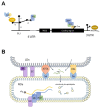Insight into the Life Cycle of Enterovirus-A71
- PMID: 40006936
- PMCID: PMC11861800
- DOI: 10.3390/v17020181
Insight into the Life Cycle of Enterovirus-A71
Abstract
Human enterovirus 71 (EV-A71), a member of the Picornaviridae family, is predominantly associated with hand, foot, and mouth disease in infants and young children. Additionally, EV-A71 can cause severe neurological complications, including aseptic meningitis, brainstem encephalitis, and fatalities. The molecular mechanisms underlying these symptoms are complex and involve the viral tissue tropism, evasion from the host immune responses, induction of the programmed cell death, and cytokine storms. This review article delves into the EV-A71 life cycle, with a particular emphasis on recent advancements in understanding the virion structure, tissue tropism, and the interplay between the virus and host regulatory networks during replication. The comprehensive review is expected to contribute to our understanding of EV-A71 pathogenesis and inform the development of antiviral therapies and vaccines.
Keywords: enterovirus 71; life cycle; virus–host interaction.
Conflict of interest statement
The authors declare no conflicts of interest with respect to the publication of this paper.
Figures



References
-
- Messacar K., Spence-Davizon E., Osborne C., Press C., Schreiner T.L., Martin J., Messer R., Maloney J., Burakoff A., Barnes M., et al. Clinical characteristics of enterovirus A71 neurological disease during an outbreak in children in Colorado, USA, in 2018: An observational cohort study. Lancet Infect. Dis. 2020;20:230–239. doi: 10.1016/S1473-3099(19)30632-2. - DOI - PMC - PubMed
Publication types
MeSH terms
Grants and funding
LinkOut - more resources
Full Text Sources

